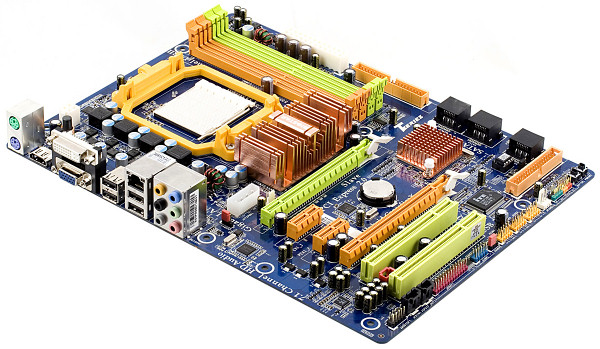Biostar TA790GX A2+ Motherboard
|
Biostar is still very responsive, being one of the first companies to launch products on recently announced chipsets. Engineers from this company couldn't possibly miss AMD 790GX, as this chipset successfully combines the most progressive integrated graphics core, CrossFire support, and excellent peripheral functionality, which has become even better than in AMD 780G+SB700 owing to the SB750 Southbridge. As a result, Biostar currently offers four models on this chipset (several more are coming). But most of them do not differ much from each other in functionality and design. We'll examine almost the least functional ATX modification.
 
Examination of the motherboard brings us only to a trivial conclusion -- engineers fully implemented chipset functionality, having avoided all widespread drawbacks (to be more exact, known ones, which are still of rare occurrence). So we can criticize the motherboard only for the lack of interesting addons, which might have marked it among its competitors. However, even this accusation is groundless, because a motherboard must be inexpensive, that is stand out from other models with its price, not its original features. Hypercritical users may dislike that the first and the second graphics ports are swapped. So when a single card is installed in the far slot (according to the manual), it will block scarce PCI ports. Besides, note the original way to switch between operating modes of PCI Express x16 ports: if a single graphics card is installed and you want this port to get all 16 lanes, you should install a special bundled card into the vacant port. However, Biostar typically designs hardware circuits to switch between modes, just be happy that you don't have to use jumpers, like in TPower N750.

The heat sink is long and high. But it's placed at the right distance from a processor socket, so it won't interfere even with a bulky CPU cooler, and it provide indirect cooling, which may come in handy, if you decide to overclock the graphics core. Memory chip for the integrated graphics core (64 MB DDR2-533 Hynix HY5PS121621CFP, DDR2-400 by default in BIOS) is partially covered by the heat sink of the Northbridge, but there is no contact between them. However, judging by operating temperatures, there is no need to improve the cooling system.

The 4-phase switching voltage regulator of the processor incorporates three field-effect transistors per channel, 7 x 820 uF and 4 x 270 uF capacitors (brand products with polymeric electrolyte; you may read the markings on field-effect transistors and other components on the close-up photo, just click the photo above) There are no empty seats on the board. However, similar design is used in two more products: the SE board lacks the SidePort video buffer, while the TA790GX 128M motherboard is equipped with an enlarged 128MB video buffer (of the same memory type -- DDR2), and finally, TA790GX3 A2+ comes with 128 MB of DDR3 memory. Motherboard dimensions -- 305x225 mm (narrow microATX), seven-screw mount, one edge of the board with HDD and power connectors is not fixed.
System monitoring (ITE IT8718F-S, BIOS Setup)
- Voltages on a processor core, memory, chipset, HT bus, +3.3, +5, +12 V, +5 V Standby and battery
- RPM of three fans
- CPU and board temperatures (by the corresponding embedded sensors)
- SmartFan -- automatic rotational speed control for CPU and system coolers. You can influence the standard algorithm of the CPU fan by specifying the priority (Quiet or Performance). If you don't like the automatic control in these modes, you can specify thresholds manually:
- Fan Ctrl Off -- when temperature drops below this value, the fan stops (or slows down to minimum, specified by Fan Ctrl Start value)
- Fan Ctrl On -- when the temperature exceeds this value, the fan starts and its speed grows gradually as the temperature grows (in other words, you can specify different values for starting and stopping the fan, in order to avoid frequent ons/offs)
- Fan Ctrl Start value -- it's a relative value that determines a threshold voltage (maximum voltage corresponds to 128 units here) necessary to start a fan. Different fans may require different voltages to start up. Automatic calibration option in BIOS will help determine this value for your fan.
- Fan Ctrl Sensitive -- it's a relative value that determines rotational speed acceleration per 1°C, automatic calibration helps find the optimal value.
System monitoring data are displayed at startup during POST -- it's a traditional feature in Biostar motherboards. The system is compatible with 3-pin and 4-pin fans. Auto calibration is another praiseworthy feature -- the motherboard detects how the voltage applied affects CPU fan speed. It's no secret that there are no established standard here. So most SmartFan implementations have limited compatibility with coolers. Users are often forced to disable these modes and use expensive hardware controllers. You can also control coolers using T-Utility in Windows. System monitoring in modern T-Series motherboards from Biostar produces the best impression out of all solutions. Its convenience resembles abit motherboards for serious users. It only lacks a similar option to control system fans to become perfect.
Write a comment below. No registration needed!
|
|
 |
|
|
|

